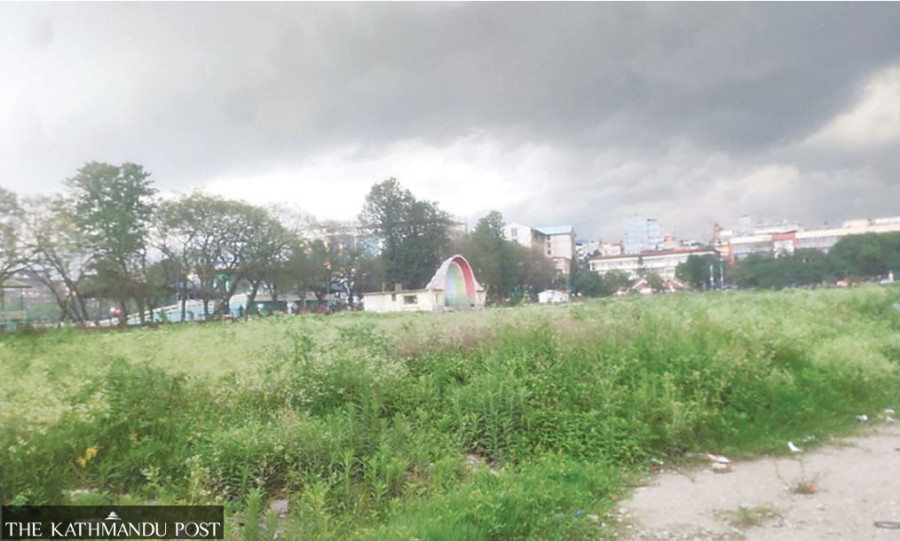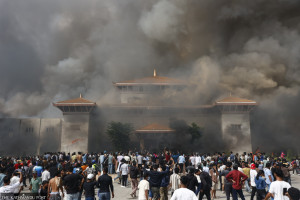Kathmandu
Conservationists decry underground parking plans at Khula Manch
Fear is that the ‘hasty and unilateral’ decision, if put into action, could damage local soil ecology and the aquifer.
Anup Ojha
On Tuesday, the 10th executive meeting of the Kathmandu Metropolitan City (KMC) approved a proposal to prepare a detailed project report (DPR) for a three-storey underground parking facility and a water recharge pit in the historical Khula Manch (open air theatre) with support from the municipal development fund. Heritage conservationists, groundwater experts and locals, however, are concerned about the plan and worried about the project’s ecological impact.
The KMC, which had recently cleared debris (from the 2015 earthquakes) and wild bushes at Khula Manch, on Tuesday made a new announcement after its executive meeting at City Hall. Half of the Khula Manch area was used as a bus park until last year.
“At first, we were happy to see the City clearing the bushes and debris from the Khula Manch, but we were then taken by surprise when we learned of the underground parking plan,” said Ganapati Lal Shrestha, a conservation activist and Basantapur resident.
“Shouldn't the municipality officials consult locals and heritage activists before taking such decisions?” Shrestha questioned.
After continuous protests by heritage activists, locals and citizen-led groups calling for vacating Khula Manch in 2019, municipal officials had finally cleared the bus park and padlocked its gate on April 28 last year. Since then, the open space at the heart of Kathmandu had been in a derelict condition. During Dashain, it was used as a parking lot.
“Imagine the area’s condition if the metropolitan office makes a three-storey underground parking. This will have an impact on local stone spouts, many of which have already gone dry,” said Shrestha, demanding that the City not use the open space for any other purpose.
Groundwater expert Padma Sundar Joshi of the UN Habitat Nepal said making underground parking could be a way to manage Kathmandu’s traffic problem. “But, for a three-storey underground parking facility, the land has to be dug up 30-40 feet and this will greatly impact the underground water system.”
“First of all, the metropolitan office leadership should conduct a thorough geological study to better understand the soil property and the project’s impact on the water recharge system,” Joshi added.
The City office is yet to give details on how many vehicles can be parked in the basement parking facility at one time, as well as on the size and capacity of the water reservoir.
“The capacity, the area it covers and the model of the water pit will be disclosed only through the DPR. Right now, we can’t say anything,” said Nabin Manandar, spokesperson for the metropolitan city.
Meanwhile, Alok Siddhi Tuladhar, one of the initiators of the Occupy Tudikhel campaign launched in 2019 to reclaim encroached public spaces, said there is room to doubt the KMC’s intent. “The metropolitan city’s executive meeting has passed a proposal to prepare a DPR, but who advised it to do so?” said Tuladhar.
“Before coming to a decision on a historical place, shouldn't it have consulted the public and those involved in the Occupy Tundikhel campaign?” said Tuladhar.
Others suspect the City's announcement of the underground parking in Khula Manch is an attempt to divert public criticism from its failure to build a bus terminal. Mayor Balendra Shah’s administration has long been criticised for not building a bus park, inconveniencing people who need to travel to the outskirts of Kathmandu as they have no proper spots to board vehicles.
In 2016, the city had decided to use half of the Khula Manch as a bus park to facilitate the construction of a view tower at the old bus park site. The City had planned to use the tower’s basement and the first floor as a bus terminal, but the tower is still under construction, and the capital city is without a bus park.
“I had heard that Mayor Shah was thinking about meeting stakeholders on the issue, but on Tuesday, the City officials all of a sudden decided on their own. This is condemnable,” Shrestha said. “Under no condition should the subsoil in the area be damaged as that would directly affect groundwater recharge.”
According to Shrestha, heritage conservation activists are planning to submit a memorandum to the mayor on the issue.
When contacted, Bhoop Dev Shah, secretary to the mayor, said the City will make its position clear only after the DPR is ready. “The metropolis had incorporated the proposal in its annual plan. The conservationists should have raised this issue earlier,” said Shah.
“The DPR will have details of soil condition, topography, and underground water pumping system. It will be a scientific process, and if the DPR finds faults, the project may not go ahead, or we can then consider another scientific approach to address it,” reassured Shah.
Conservationist Tuladhar, however, says the municipal office can easily manipulate the company that is chosen to prepare the DPR. “Given the size of investment, officials can easily influence the particular company to decide in its favour.”
This, however, is not the first time an underground parking facility has been discussed. The then mayor Bidya Sundar Shakya in 2017 had also announced plans to build a five-storey automated parking facility at Dharmapath and underground parking lots at Khula Manch and Lainchaur, but the idea never materialised.




 10.12°C Kathmandu
10.12°C Kathmandu.jpg)











